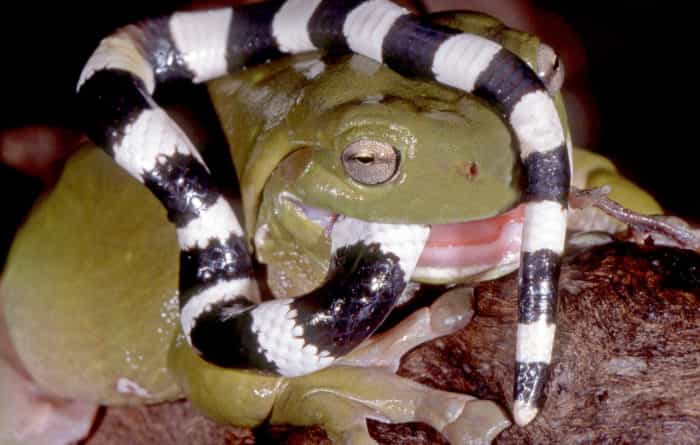Beautifully striped, terribly in danger: Meet Australia’s bandy-bandy snakes

DECORATED IN hypnotising black and white stripes, the bandy-bandy snake (Vermicella) is easily recognised and much-loved by Australians.
Commonly found in the woodlands of the Northern Territory and Western Australia, six different species belong to the bandy-bandy genus – all similarly coloured and patterned – with a new species only having been found just last year.
The word bandy itself means to toss from side to side, which describes the way these snakes move, which is similar to the way a black-and-white-striped zebra moves with a herd.
And just like zebras, or even human fingerprints, every bandy-bandy snake has its own unique number and thickness of stripes.
Unlike its more dangerous counterparts: the king brown, red-belly or the taipan, the bandy-bandy is far less deadly.
Rather, the bandy-bandy frightens off predators by raising and looping its body in the air, presenting a provocative silhouette, then quickly taking the safest exit.
Their venom is far more potent on other snakes than it is on mammals, which is why they often prey on their fellow reptiles.
Even Australia’s green tree frogs are willing to risk taking them on:

(Image credit: Ken Griffiths)
Snake expert Bryan Fry from the University of Queensland says the bandy-bandy snakes are one of his all-time favourites.
“I think they are the cutest things ever. They are just so beautiful, I love that extreme contrast between the deepest black and the purest white you could imagine,” he says.
According to Bryan, all bandy-bandy snakes do the characteristic looping, aiming to look tough, but he says they’re the most inoffensive animal.
“I think one thing that makes the bandy-bandy so cool and unusual is that behavioural display.”
Bryan was out in the Cape York Peninsula leading a team of biologists to conduct sea snake research when he came across something peculiar, a bandy-bandy snake lying on a concrete fishing ramp.
To his surprise and delight, he and his team had discovered a new species of bandy-bandy, named the Weipa bandy-bandy (Vermicella parscauda).
“I would love to say that we were doing something clever, but it was just a total wonderful accident,” Bryan says.
Bryan was so surprised that he thought maybe one of his local mates was playing a trick on him.
“I thought that someone may have put it purposefully on the dock for a bit of a laugh,” he remembers.
The new species was discovered a couple of hundred metres from a bauxite mining site neat Weipa, a town on the west coast of Cape York, where it’s existence is constantly under threat.
Bryan explained that the hyper-banded colouring was something they had only seen in snakes that lived in the monsoonal habitat of WA and the NT. He said finding this new bandy-bandy nowhere near the range of the other bandy-bandy snakes was very strange.
“I felt a combination of being amused, confused and excited because I could tell that the discovery was something very unusual,” he said.
It is believed that one continuous monsoonal habitat used to exist covering the area of WA, NT and Cape York, but this has now been split into three different habitats.
After the split each species became isolated and continued on their own evolutionary trajectory.
For this reason, Bryan and his team predict there could be more bandy-bandy snakes further down the cape.
Bryan explained that this particular species of bandy-bandy snake differs from the bandy-bandy snakes in the Northern Territory and Western Australia as it has internasal scales.
This distinguishing difference means that the split nasal feature evolved after the Northern Territory snakes split from their common ancestor.
Bryan tells Australian Geographic that, while discovering a new species is exciting, he was instantly concerned for its safety as its only known habitat is being destroyed by mining.
“This type of bauxite mining activity can have hidden ecological impacts on these types of burrowing animals,” he says.
Land clearing for bauxite mines remains a large problem for other native wildlife as well. The mining has been detrimental to the 200-year-old hallowed out trees that provide nesting areas for birdlife such as the Cape York Peninsula’s palm cockatoo.
Bryan worries that we may be losing more wildlife than we’re aware even exists.
The scientists have applied for the new bandy-bandy snake to be granted protection status, which they hope will ensure it has a future.





